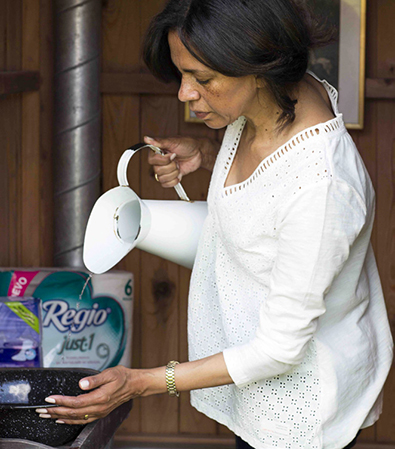External trends and drivers
Global macrotrends, from increased population and higher living standards to resource shortages and climate change, have a major impact on Essity’s business operations. We have identified a number of macro-economic drivers that are relevant to our business. By analyzing our external environment, we can capitalize on opportunities and avoid the risks associated with them.
Growing and aging population
The world’s population is growing and living longer. The global population is today just over seven billion. The UN predicts that this figure will grow to more than nine billion by 2050.
This growing population is resulting in an increased demand for hygiene and health products and thus creating favorable growth opportunities for Essity. The greatest global population increase is expected to occur in Asia, Latin America and Africa. Our presence in most of these markets and our offering of adapted products is thus strategically important. Essity is prioritizing growth in selected emerging markets, such as China, Southeast Asia, Latin America, Eastern Europe and Russia.
An aging population will put more pressure on the elderly care system and an increasing number of elderly people will require homecare. At the same time, we are continuing to lead active lives at an older age. More elderly people is increasing demand for incontinence and health products, both in mature and emerging markets. For example, the occurrence of incontinence among people over the age of 65 is expected to be between 15 and 20%.
Higher standard of living
At the same time as the population is growing, the level of poverty in the world is decreasing. An increasing number of people earn more than USD 2 per day (the World Bank’s definition of poverty) or have moved into the middle class, meaning they earn more than USD 4 per day (according to the UN Millennium Development Goals Report 2015). Once people’s most basic needs for food and shelter are met, hygiene becomes a top priority. Essity expects disposable income and higher living standards to continue to drive demand for hygiene and health products. In emerging markets, Essity sells hygiene and health products and solutions that are specially adapted to consumers with limited resources.

Global insight into hygiene and health
Limited or no access to hygiene and sanitation is one of the greatest global challenges. There is a growing awareness of the relationship between good hygiene and health, and how this improves well-being in the world, as indicated by the UN’s 17 Sustainable Development Goals. Access to good personal hygiene impacts health, dignity and participation in society, such as in education and working life. Hygiene is a catalyst for economic growth. Hygiene is also key in avoiding the spread of infection, not only in the most basic situations and in emerging markets. Good hygiene also reduces the spread of, for example, antibiotic-resistant bacteria, which is a major challenge in modern healthcare. Essity continuously develops new hygiene and health solutions and is educating, for example, healthcare & medical staff in incontinence and good hand hygiene. Young women are educated about menstruation and puberty, and children and preschool teachers are taught about the importance of good hand hygiene. Incontinence products enable people to live more active and dignified lives. Though taboos and stigma exist about such issues as menstruation and incontinence in both emerging and mature markets. Improved knowledge is important to elevate hygiene and health standards as well as well-being.
Increased prevalence of chronic conditions and access to healthcare
Chronic diseases are on the increase in mature and emerging markets. Costs related to chronic diseases are rapidly increasing worldwide. Increased prevalence and greater life expectancy of people with chronic conditions are expected to drive demand for health products and thus innovations in wound care, compression therapy, orthopedics and incontinence products. At the same time as welfare states and healthcare budgets are under pressure in mature markets as a result of longer life expectancy and growing populations, healthcare investments are on the increase in many emerging markets in line with their economic growth. Regardless of where they take place, hygiene and health solutions are often investments that reduce total costs in society. For example, preventive initiatives, such as hand hygiene and good wound care, can reduce the risk of spreading infections.
Sustainable consumption and the circular economy
Limited resources, political priorities and knowledgeable, conscious customers and consumers are increasing expectations on, and demand for, sustainable products and solutions. Essity’s ambition is to develop products and solutions that are compatible with a sustainable and circular society.
Circularity is a business model that involves striving to reduce resource consumption in the design of products and solutions and in connection with production and consumption, and to offer efficient reuse, recycling or composting of our products, which reduces consumer waste.
Digitalization
The digitalization of our society entails substantial changes and opportunities. Conditions are altered, new needs and business models arise and new players enter the market. For Essity, digitalization offers a variety of opportunities to improve and evolve all parts of our value chain, but it also presents challenges to identify sustainable and profitable business models. We are digitalizing production, administration and logistics to achieve efficiency and quality enhancements. In product development, we are working to create digital solutions that improve our offering to customers and consumers.
We communicate and interact with customers and consumers through social media and our product brand websites, such as www.tena.com, www.libresse.com and www.libero.com. For each year that passes, Essity’s products are increasingly sold and marketed online.

The company behind the brand
More than ever before, customers and consumers are paying attention to the companies behind the products and solutions they buy and imposing greater demands on these companies in terms of corporate responsibility. Responsibility and sustainability are deeply integrated into Essity’s business, which is based on a sustainable business model with focus on value creation for people and nature.
Scarce resources
As a result of the growing global economy and world population, an increasing number of people are now sharing the planet’s resources.
Energy: The International Energy Agency (IEA) predicts that the global need for energy will increase by one third by 2040, which will probably entail higher costs, increased environmental impact and, in some cases, an energy shortage. As a major energy consumer, this is an important issue for Essity and we continuously work to enhance our energy efficiency. New technology is not only resource-efficient, but often also generates fewer emissions.
Water: The UN predicts that two thirds of the world’s population may live in areas with water shortages by 2025. Access to water is critical for people, industry and agriculture. Essity’s production operations are dependent on access to water and we therefore have ambitious targets for efficient and responsible water usage.
Responsible fiber sourcing: Illegal felling and felling of forests with a high conservation value contribute to global deforestation and constitute a threat to biodiversity. Essity has a Group target for checking the origin of all wood raw material and for purchasing certified fiber. We also use a large share of recovered paper in production.
Human capital: The economic progress of the world’s emerging markets and increasingly knowledge-intensive business is increasing the need for skilled labor and management. We are investing in the development and training of our employees and taking a strategic approach to meeting future requirements for employees and expertise.
Climate change
Climate change is one of the most critical environmental and social issues facing the world today and the private sector is expected to play its part. Essity is actively working to combat climate change across the value chain. By conducting life cycle assessments, we can identify the areas of the value chain with the largest environmental impact. Initiatives can then target these areas to minimize climate impact.
In order to minimize our resource use, we work with innovations, efficiency enhancements, investments in new technology and increasing the share of renewable energy used at our sites.
UN’s 17 Sustainable Development Goals
The UN’s 17 global goals are a clear and welcome framework to address the world’s challenges and opportunities. Public and private players have an important role to play. Essity’s operations, focusing on hygiene and health, directly contribute toward some of the UN’s 17 global goals (including goals 3, 5, 6, 12, 13 and 15). In 2017, Essity endeavored to set out the business opportunities these specific goals give rise to in, for example, hygiene and health and sustainable consumption and production. In so doing, we can contribute toward a more sustainable world while at the same time generating profitable growth for Essity. Through partnership with others who are facing similar challenges and also see opportunities, Essity hopes to create synergies that can contribute to sustainable progress.